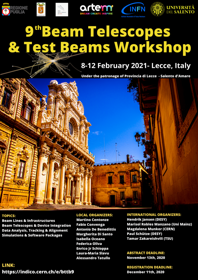Speakers
Description
The Analogue Hadron Calorimeter (AHCAL) developed by the CALICE collaboration is a scalable engineering prototype for a detector at future electron-positron energy frontier colliders. It is a sampling calorimeter of steel absorber plates and 3*3 cm$^2$ plastic scintillator tiles individually read out by silicon photomultipliers (SiPMs) as active material. The front-end ASICS (SPIROC2E) are integrated into the active layers of the calorimeter. They are designed for minimal power consumption by rapidly cycling the power according to the beam structure of a linear accelerator.
A large prototype with 38 active layers of 72*72 cm$^2$ size with nearly 22000 readout channels has been constructed, commissioned and tested in particle beams at DESY and CERN in 2018. While the analysis of these data is progressing, alternative scintillator geometries (mega-tiles instead of tiles individually wrapped in reflective foil) and an alternative readout ASIC (KLauS) have been studied in further beam tests of small prototypes. In addition, the hit time resolution has been investigated (see also separate abstract).
This presentation gives an overview of the AHCAL engineering prototype and its recent beam tests.
One of the main design drivers at future energy-frontier e+e- colliders is the precise determination of the energy of particle jets. This is achieved with detector designs optimized for the particle flow paradigm. CALICE is an R&D collaboration focussed on the development of highly granular calorimeters optimized to aid this paradigm by providing high spatial resolution. The Analogue Hadronic Calorimeter (AHCAL) is one of the detector concepts based on the SiPM-on-Tile technology, using scintillating tiles read out by Silicon Photomultipliers. A key aspect of the recently completed technological prototype is the capability for single-cell time stamping on the nanosecond level, which is important for background rejection and may provide additional benefits for energy resolution and shower separation. To investigate the intrinsic time resolution of this technology, a test beam setup has been designed and tested at DESY in October 2020. In this setup four scintillator tiles arranged as a “beam telescope” are read out by precise digitizers, allowing detailed studies of the time structure of the detector response. This contribution focusses on the details of the experimental setup as well as on the discussion of first results.
